Small lemon trees are a great choice if you’d like to grow a citrus tree but don’t have a lot of space.
In this article I’ll discuss the best small lemon tree varieties, how to prune lemon trees so that they stay compact and I’ll show you how to grow lemon trees in containers.
This post contains affiliate links. Please read the disclosure for more info.

Choosing the Right Lemon Tree Variety
When shopping for a lemon tree, you’ll want to look for dwarf or patio varieties.
These varieties are grafted onto dwarf rootstocks to speed up fruit-bearing and ensure they remain compact in size.
Dwarf lemon trees usually grow to about 6 feet (180 cm) tall and 4 feet (120 cm) wide.
Some popular dwarf lemon tree varieties suitable for small spaces include:
- Eureka: Eureka lemon trees are one of the most popular lemon trees, known for their hardiness and abundant fruit production.
- Ponderosa: This variety is known for its large, juicy fruit and pretty purple flowers. These trees are compact and slow-growing, so they’re perfect for container gardening.
- Meyer: Meyer lemon trees are popular for their sweeter, less acidic fruits and their compact growth habit. These trees are great for growing in containers or small gardens.
- Improved Dwarf Lisbon: As the name suggests, this is a compact version of the Lisbon lemon tree which is more suitable for small spaces or container gardening. Dwarf Lisbon lemon trees are thorny and evergreen, and the fruits have a sharp, acidic taste.
Advantages of Keeping Lemon Trees Small
As a landscape gardener specializing in urban gardens, I’ve found that small lemon trees are much easier to manage and care for in small spaces.
Pruning is easier due to the reduced size, allowing you to shape the tree and remove unwanted growth without much effort.
Dwarf lemon trees grow well in containers and if you place them on a plant stand with wheels you can easily move them around to different areas of your garden or patio to get the right amount of sunlight or protect them from harsh weather conditions.
This flexibility makes it possible to grow lemons even in regions where they wouldn’t usually thrive outdoors.
Keeping lemon trees small can help enhance fruit production.
Grafted lemon tree varieties tend to bear fruit more quickly than non-dwarf varieties and their compact size allows more energy to be focused on fruit production, leading to an abundant yield.
It’s easier to harvest lemons from compact trees because they don’t require as much ladder climbing as larger trees.
Growing Lemon Trees in Pots
I like growing lemon trees in pots to help maintain their size and keep them small.
You’ll need to choose a container that’s large enough for the roots to spread out comfortably, but not so large that the soil retains too much moisture.
Clay or terracotta pots are ideal because they allow for good drainage and airflow, both of which are important for citrus trees.
Fill the pot with a good quality potting mix that drains easily.
Make a hole in the soil and place the tree in it, making sure the roots are completely covered.
Water your lemon tree regularly, but don’t allow the soil to become waterlogged because too much water can cause root rot and other diseases.
You’ll also need to fertilize the tree every 3 to 4 months to ensure it has enough nutrients.
I like using these slow release citrus fertilizer spikes.
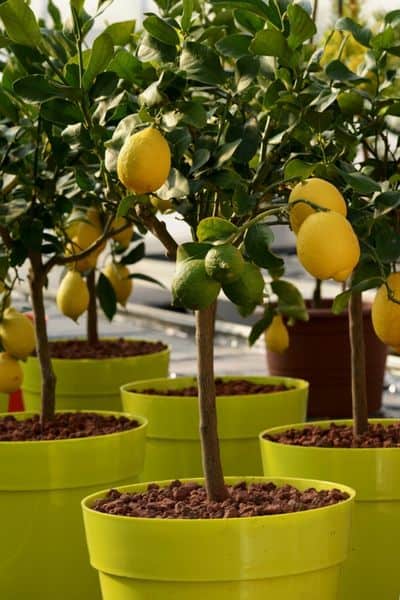
Pruning Lemon Trees
Pruning is an essential part of maintaining your lemon tree’s size and health.
Regular pruning helps to shape the tree and encourages new growth which leads to more flowers and fruit.
Formative pruning
Formative pruning is essential for shaping young lemon trees and encouraging a healthy growth habit.
This process should begin in the tree’s first or second year.
To start, remove any shoots sprouting from the base of the tree, as these are suckers from the rootstock (The Spruce).
Next, remove the lower branches to create a single, sturdy trunk.
Choose two or three main branches and remove the middle stem to open up the tree’s center.
Maintenance Pruning
Maintenance pruning will keep your lemon tree small and manageable.
This should be done in late winter as the fruit season ends.
You can also give the tree another light prune in late spring or early summer before the season starts.
For maintenance pruning you should focus on removing any branches that point inwards.
Also, remove any deadwood and overcrowded branches to promote better airflow and allow the sunlight to reach the center of the tree.
Keep the tree’s overall size in check by reducing the length of the branches, but don’t prune more than one-third of the tree in a year.
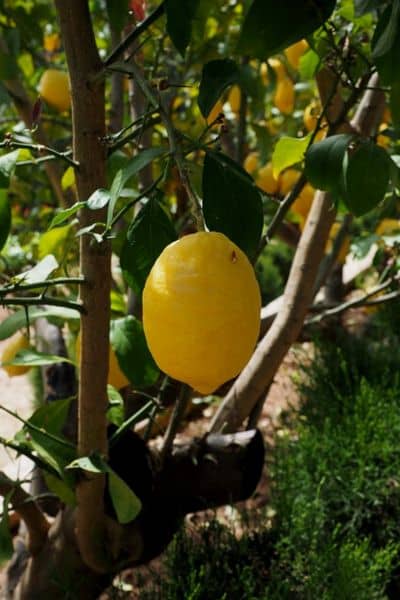
Root Pruning
Root pruning is another useful way to limit the size of potted lemon trees.
This involves carefully removing the tree from its container, trimming away about 2 inches (5 cm) of the roots using a knife, and planting the tree back in the pot with fresh potting soil.
Root pruning should be done every two to three years to maintain the tree size and encourage healthy root growth.
RELATED ARTICLES
- How To Harvest Lemons
- 11 Best Fruit Trees To Grow In Containers
- How To Keep Birds Away From Fruit Trees
So there are my tips for planting, pruning and caring for a small lemon tree.
With the right lemon tree variety and regular pruning, you can maintain a compact lemon tree in your garden or even as an indoor plant.
Have you tried growing a dwarf lemon tree? Let me know in the comments below.
Are you on Pinterest? I have boards dedicated to Growing Fruit and Urban Gardening that you may enjoy. You can also find me on Facebook.


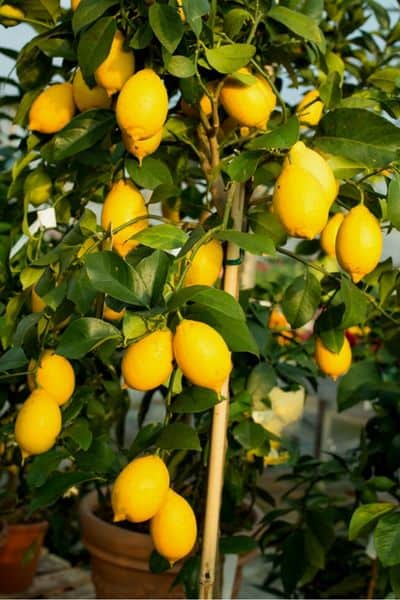
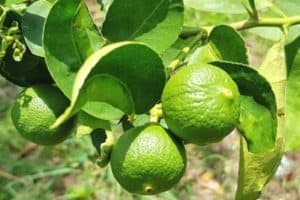

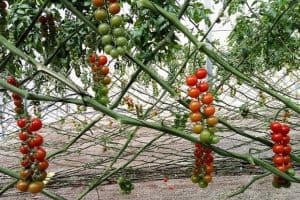

Loved the article. I have a Meyer lemon tree. I live in Illinois so it has to come in in the fall. It seems to be growing out of control since I put it outside this spring.